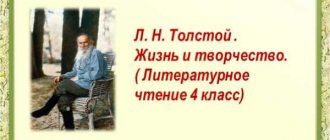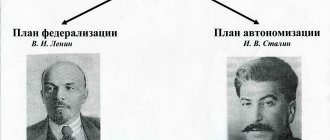Physics lesson on the topic “Electrification of bodies.” Two types of charges"; 8th grade.
Lesson type:
combined.
Cognitive purpose of the lesson:
study of the phenomenon of electrification, the concept and properties of electric charge.
Developmental goal:
development of logical thinking, development of practical skills in understanding natural phenomena. As a result of work in the lesson, students should know/understand: a) the phenomenon of electrification - the phenomenon of the body acquiring an electric charge; b) an electric charge can be transferred from an electrified body to a non-electrified one (by friction or contact); c) electric charges are of two types - positive and negative; d) bodies with like charges attract, and opposite charges repel; e) an electroscope (electrometer) is used to detect and measure electric charge; f) concepts: electrification, electric charge, electrometer, electroscope, dielectric, conductor.
Students should be able to determine in practice the type of interaction of electric charges, model the phenomenon of electrification, and also explain everyday situations that are caused by these phenomena, using the concepts studied in the lesson.
Equipment and teaching aids: multimedia computer and projector, screen, set for students’ frontal experiment.
The lesson is presented in the form of a presentation. Demos:
electrification of ebonite and glass rods, transfer of electric charge from an electrified ebonite rod to a non-electrified sleeve, interaction of two charged ebonite rods, interaction of charged glass and ebonite rods, interaction of like and unlike charged electric plumes, action of an electrometer, transfer of electric charge by a conductor, action of a dielectric, interaction of a charged ebonite stick with a stream of water and a book sheet, attraction and repulsion of charged cartridges.
Lesson plan:
1. Organizational moment 2. Checking homework 3. Introduction 4. Studying new material 5. Consolidating material 6. Recording homework
Lesson progress: 1. Organizational moment 2. Checking homework 3. Teacher's introduction, students' formulation of the lesson topic. Teacher: “Even in ancient times, people noticed that amber (petrified resin of coniferous trees), rubbed on silk, begins to attract small objects to itself.” A little later it became known that other substances also have this property: a glass rod rubbed on silk - demonstrates an experiment with an electrified glass rod (1), a rod made of ebonite (rubber with an admixture of sulfur), rubbed on fur - demonstrates an experiment with an electrified ebonite rod , and in our time, plastic bodies rubbed against paper. Conduct an experiment on electrifying a plastic ruler on paper.”
frontal experiment: students observe the attraction of small pieces of paper with an electrified ruler. Teacher: “What examples of similar phenomena that you have observed in life can you give?” Students give examples. Teacher: “That's right. All these phenomena are called electrical. They were named that way back in the 17th century from the Greek word “electron”, which means “amber”. A body that begins to attract small objects to itself after rubbing is said to be “electrified,” that is, it is given an electric charge, and friction causes electrification. Think and tell me what happened to the ruler, what word can this event be called?” Students: “It became electrified, that is, it acquired an electric charge, electrification occurred.” Teacher: What do you think the name of today’s lesson will be?” Students: “Electrification of bodies.” Teacher: “That's right. We are starting to study a new section of physics: Electrical phenomena. The topic of today's lesson: “Electrification of bodies.” Two types of charges." Today we will look at some electrical phenomena, find out what electrification is, electric charge, what types of charges there are, how electric charges interact, and also how electric charge can be detected and measured.
4. Learning new material:
Teacher: “Let’s write down the main thing of what we said. Write down: when friction occurs, the body becomes electrified, that is, it acquires an electric charge. Definition of electrification. If the body has acquired a charge, this means that it has acquired the ability to attract other objects. What definition of electric charge can we give? Students formulate and write down the definition of electric charge. Teacher: “Let’s consider some properties of electric charge.” Demonstration of the experience of transferring an electric charge from an electrified body to a non-electrified one (2) - formulation by students and recording of the first property of an electric charge Demonstration of the interaction of two charged ebonite rods, interaction of charged glass and ebonite rods (3) - formulation by students and recording of the second property of an electric charge Demonstration of the interaction of the same name and differently charged cartridges (4) – students’ formulation and recording of the third property of an electric charge. Consolidating the first part of the stage of learning new material: students’ explanation of the interaction of the leaves of electric plumes in different cases. (5) Teacher: “How do you think the existence of an electric charge can be detected?” - assumptions - demonstration of the operation of the electrometer. (6) Formulation by students and recording of the principle of operation of the device. A question to students about the possibility of an electrometer operating when replacing the material of the electrometer rod - demonstrating the transfer of electric charge from one electrometer to another using a conductor, as well as the absence of charge transfer when connecting devices with a dielectric. (7) Recording the concepts “conductor” and “dielectric”. 6. Consolidation of the studied material: answers to questions during which the main phenomena and concepts studied in the lesson are formulated, students solving qualitative problems-situations, explaining them from the point of view of the phenomenon of electrification, the interaction of electric charges, the concepts of conductor and dielectric. Demonstration of some of the situations considered. What is electrification? What properties does an electric charge have? What device measures electric charge? What is a conductor, dielectric? Explain observed phenomena (demonstration of phenomena). (8,9,10) Tasks to explain the interactions of electrified bodies, as well as the transfer of charge by dielectrics, made in the form of drawings.





